One of the highlights for me of attending this year’s Space Symposium, in its 40th iteration, at the beautiful Broadmoor in my hometown, Colorado Springs, was to see the significant international turnout. As I walked from one country pavilion and booth to the next, it became clear to me that I had to tell some of the stories of these international partners who made their way across oceans and continents to be there. I chose one company per country, as a representative example of the technology and services they are bringing to the global space community. With the exception of New Zealand and the United Arab Emirates (with whom I was unable to fully connect, unfortunately), I believe I may have truly accomplished the goal of going around the world at the event. I hope you enjoy learning about these incredible companies and organizations as much as I did!
Italy: Intella | AI-Enabled Satellite Health and Performance Optimization
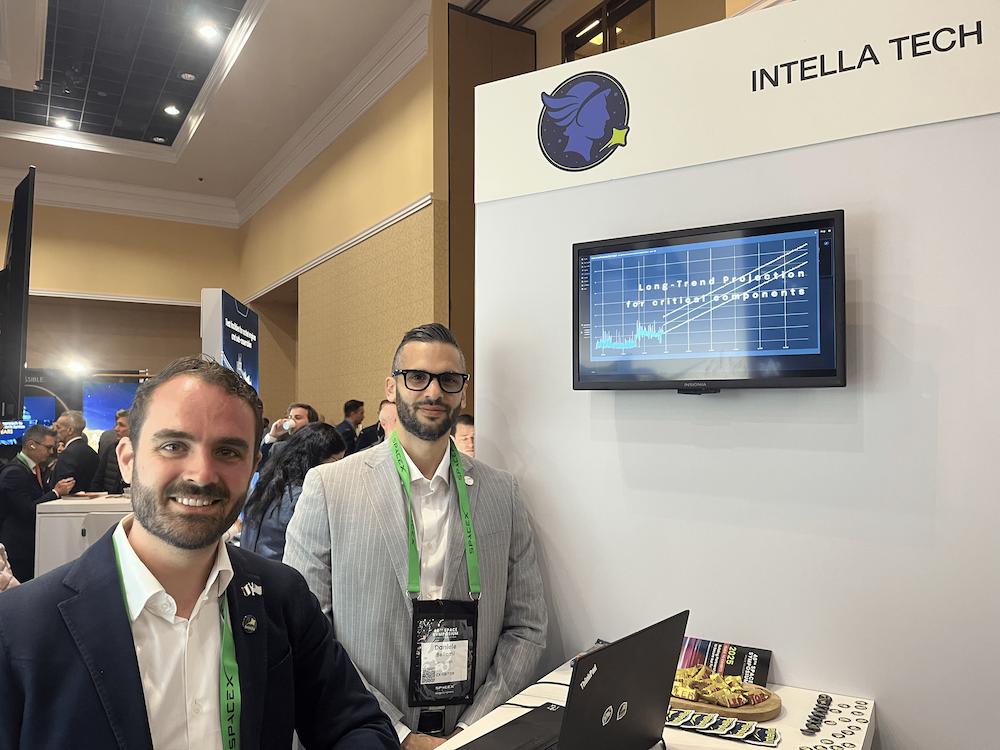
Founded in 2023 and headquartered in Milan, Intella S.r.l. provides artificial intelligence (AI) solutions for the space industry. Intella’s mission is to simplify satellite management as the number of satellites continues to grow exponentially. Its software leverages AI to automate manual processes, detect anomalies early and provide root cause analysis—all while tailoring insights to individual satellites.
What’s New: CEO Michael Hepler unveiled the company’s fully developed platform for operators with enhanced flexibility: Mercury, an anomaly detection platform designed to ensure the health and efficiency of satellites in orbit. As Helper explained, even satellites of the same model can operate under vastly different conditions, depending on their mission or orbit. Mercury leverages advanced AI algorithms to detect anomalies early, perform root cause analyses and dynamically analyze telemetry data. This capability not only reduces operational costs but also maximizes service uptime and extends satellite lifespans. As Hepler explained, Mercury acts as a “preventative health copilot,” delivering critical insights in a human-readable format to operators.
Also, beyond its cloud-based solution, Mercury can integrate directly into customers’ existing environments to meet diverse operational and regulatory needs. This adaptability is crucial in the highly customized space industry, where each mission demands unique solutions.
What’s Next: Looking ahead, Intella plans to expand its AI-driven expertise beyond space systems. “You can imagine applying these techniques to other complex systems—whether it’s ground segments or parallel industries,” Hepler noted. With finite human attention and growing data demands, Intella aims to adapt its algorithms for broader applications to make complexity a strategic asset across various industries. Learn more about Intella’s transformative technologies, visit their website or connect with them on LinkedIn. For more information about Intella’s technologies, visit their website or connect with them on LinkedIn.
Japan: Space Quarters | Futuristic Space Construction
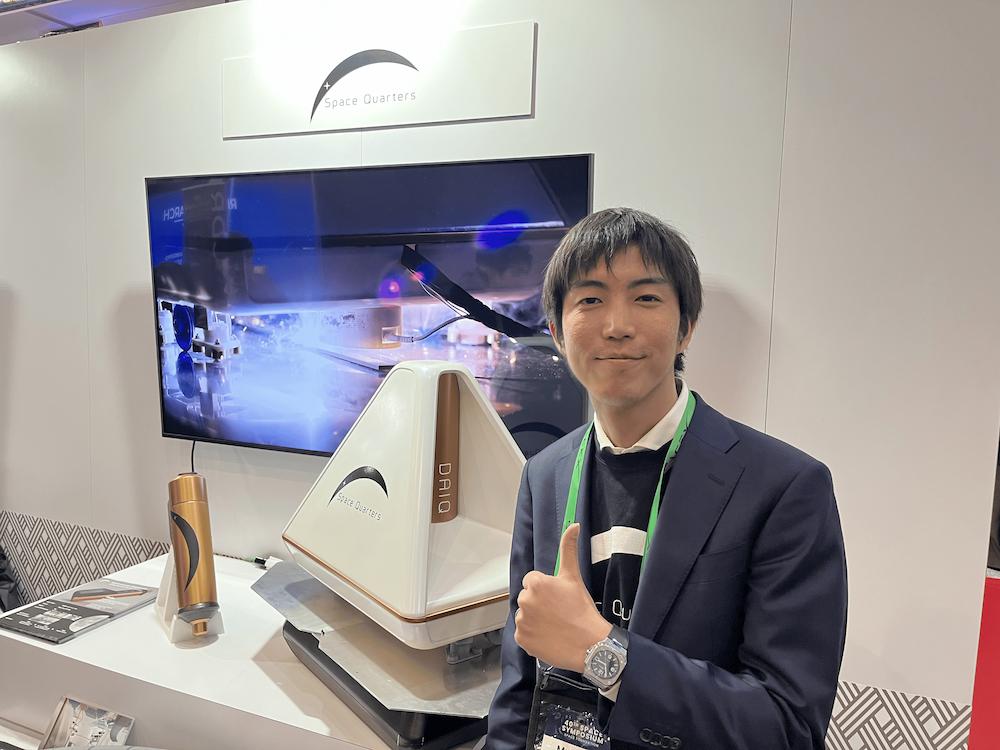
Space Quarters, a trailblazing Japanese company co-founded by Muneonori Takahashi, is redefining the future of space infrastructure. Driven by a dream of “building a city in space” and turning that into a reality, Takahashi and his team are addressing critical gaps in space technology. Specializing in robotic construction systems, Space Quarters enables the assembly of large-scale structures in orbit. Their innovative technology allows for the deployment of panels and robotic systems aboard rockets like Falcon 9, to create structures three times larger than the International Space Station (ISS) in a single launch.
What’s New: Space Quarters showcased their readiness for orbital deployment. They highlighted ground-based fabrication tests and demonstrated potential applications ranging from orbital hotels and science parks to satellite factories and massive parabolic reactors. These advancements underline their vision of building essential infrastructure in space—an area currently lacking the robust systems we take for granted on Earth, such as water, energy and transportation networks.
What’s Next: Space Quarters has ambitious milestones. By 2027, they plan to launch a demonstration mission to test their construction methods in space. This will include deploying seven panels with robotic systems to validate their capabilities. By 2029, they aim to develop pressurized modules and pave the way for full commercialization by 2031. Takahashi encourages those interested to visit their website or explore their Japan-based facilities.
UK: AAC Clyde Space | Satellite Maritime Domain Awareness

AAC Clyde Space, a global business headquartered in Sweden, specializes in providing cutting-edge small satellite technologies and services that enable businesses, governments and educational institutions to access high-quality data from space. The company’s offerings span three key areas: space products, space missions and space data and services. From onboard computers and power systems to fully integrated satellite missions supporting Earth observation and communications supporting applications in agriculture, forestry and the maritime domain, AAC Clyde Space drives innovation to improve life on Earth.
What’s New: Additive to the company’s accomplishments of having built Scotland’s first satellite, UKube-1, Dr. Pamela Smith, VP of Future Programs at AAC Clyde Space, highlighted the company’s latest announcement to develop a maritime domain awareness system using advanced satellite technology. The INFLECION project will combine the latest VHF Data Exchange System (VDES), Signal Intelligence (SIGINT), and Synthetic Aperture Radar (SAR) technologies to offer real-time insights for vessels at sea. Smith emphasized the significance of this development. “This technology has applications across logistics, port management, autonomous shipping, safety and security. It’s a collaborative program supported by the European Space Agency and UK Space Agency that will revolutionize how we monitor and manage our oceans,” she said.
What’s Next: According to Smith, AAC Clyde Space will continue to focus on expanding its data services capabilities across Earth observation and communications domains. By leveraging their expertise in small satellite systems, the company aims to deliver more robust solutions for agriculture, forestry, and the maritime environment. Learn more about AAC Clyde Space here.
Canada: Xiphos Systems Corporation | Space Computing Breakthroughs
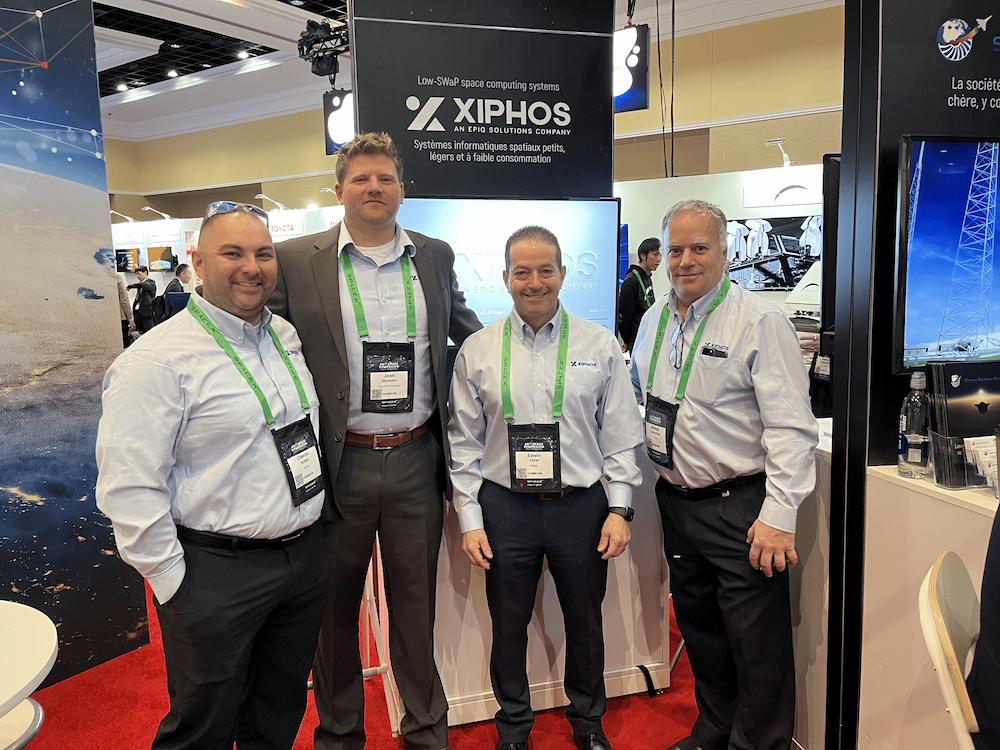
Xiphos Systems Corporation, a Montreal-based pioneer in space computing, has been at the forefront of delivering cutting-edge technology to orbit since 1996. Now operating as part of Epiq Solutions, Xiphos specializes in creating robust, space-hardened processing systems that combine commercial off-the-shelf (COTS) performance with the resilience required for harsh space environments.
Josh Duncan, Director of Space Products, shared insights into Xiphos’ core offering, which revolves around its versatile single-board computers. Designed to adapt to a variety of missions by adding modular components that give each system a unique “personality,” these systems can serve as optical payload interfaces, software-defined radios (SDRs) or even main onboard computers for satellites. They can integrate high-speed connectivity and advanced processing power while maintaining radiation resilience—a combination that enables both scalability and reliability in space.
What’s New: At this year’s symposium, Xiphos celebrated a major milestone: over 1,000 computers sold in the past two years—a testament to its growing influence in the commercial space ecosystem. Duncan also highlighted the company’s recent acquisition by Epiq Solutions, a U.S.-based leader in software defined radio (SDR) technology. This collaboration promises to merge Xiphos’ expertise in space-hardened designs with Epiq’s high-performance radio frequency (RF) capabilities for new applications in defense and beyond.
What’s Next: Looking ahead, Xiphos is focused on integrating artificial intelligence (AI) into its next-generation processors. With built-in machine learning cores designed for robust operation in orbit, these advancements aim to meet increasing demand for AI at the edge. As Duncan explained, “Our next device will allow customers to perform AI/ML directly on-chip in a very robust manner.”
France: Aldoria | Terrestrial-Based Space Situational Awareness

As space becomes increasingly congested with satellites and debris, Aldoria, a company specializing in Space Situational Awareness (SSA), has stepped up to ensure safer and more sustainable operations in orbit. Headquartered in France with a growing presence in the U.S., Aldoria leverages its proprietary network of 19 ground-based optical sensors to monitor objects across all orbits. Their innovative multi-telescope system synchronizes four telescopes for mass surveillance in Low Earth Orbit (LEO) and targeted tracking, delivering high-accuracy data as a service to operators worldwide.
What’s New: Rapid satellite proliferation and growing defense capabilities in space have created challenges that Aldoria is rising to meet. Saloua Moutaoufik, Strategic Partnership Manager at Aldoria spotlighted the company’s cutting-edge SSA solutions, with an emphasis on collision avoidance, constellation monitoring and maneuver recommendations. These services which help operators navigate the increasingly complex orbital environment, she explained, are pivotal for space traffic management and national security. By offering near real-time insights into object trajectories and proximity operations, Aldoria ensures both operational safety and strategic intelligence.
What’s Next: Supported by the European Union’s Innovation Council, Aldoria plans to expand its sensor network to achieve comprehensive coverage across all orbital paths. This ambitious goal aligns with their commitment to enhance global space safety and sustainability. Visit Aldoria’s website to discover more about its SSA innovations.
Singapore: Aliena | Space Propulsion Bringing Space Closer to Home

A pioneering space-tech company based in Singapore, Aliena, hopes to reshape the satellite propulsion landscape with its cutting-edge electric engines. Founded by Dr. Lim JW Mark, a plasma physicist with extensive experience in academia and civil service, the company specializes in miniaturized electric propulsion systems designed for small satellites to enable flights closer to the Earth for a variety of purposes. Aliena launched its first plasma thruster in orbit a little over three years ago.
What’s New: Aliena’s latest advancements revolve around low-power, high-thrust electric propulsion systems. Mark engineers these thrusters to address the constraints of power budgets and onboard storage in smaller satellites while maintaining fuel efficiency. These systems allow satellites to access and operate efficiently at lower altitudes, including in very low Earth orbit (VLEO). This capability unlocks higher resolution imaging, reduced latency in communications and improved signal-to-noise ratios for emerging technologies like quantum key distribution (a method that uses the principles of quantum mechanics to securely exchange cryptographic keys between two parties) – and sets new industry standards for future space missions.
What’s Next: In Mark’s words, Aliena aspires to become the “Rolls-Royce of satellite propulsion,” establishing itself as the go-to brand for electric satellite engines. He envisions a future where Aliena’s name becomes synonymous with satellite propulsion, much like Xerox or Google in their respective domains. For more information about Aliena’s groundbreaking work, visit their website or connect with them on LinkedIn.
Denmark: Space Inventor | Rapid Satellite Manufacturing
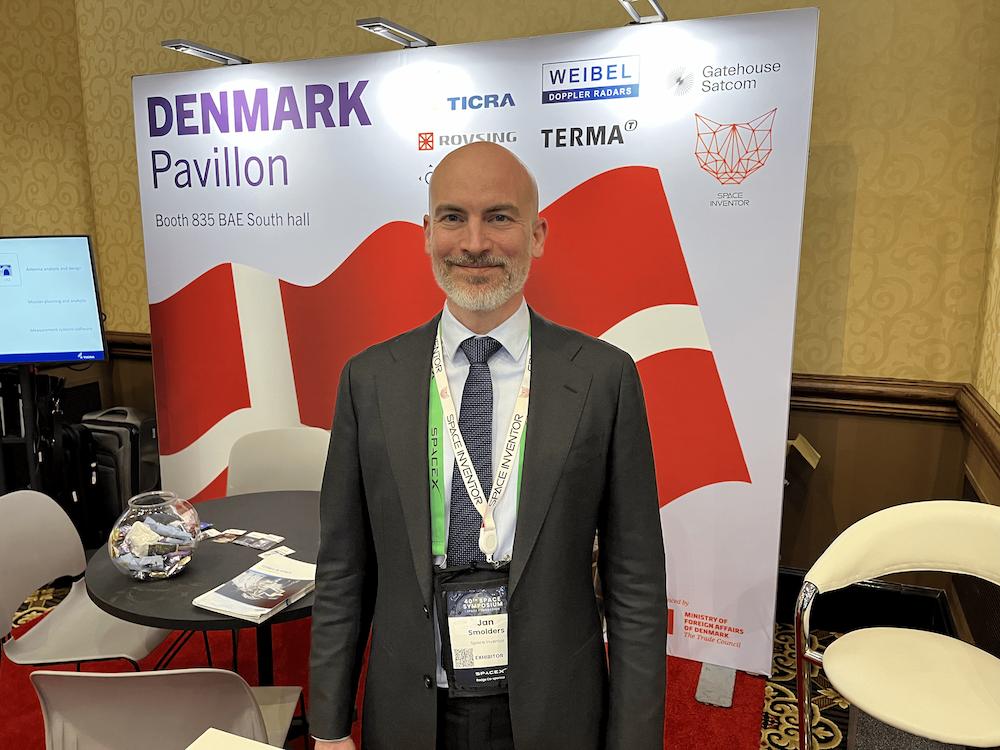
Another standout exhibitor, Denmark-based Space Inventor is redefining the satellite industry with its innovative approach to manufacturing and mission delivery. Founded a decade ago and headquartered in northern Denmark, this agile company specializes in designing and producing microsatellites and satellite components for commercial, governmental and military applications. With a global footprint spanning Europe, Asia and the United States, Space Inventor has become synonymous with speed, scalability and cutting-edge technology.
What’s New: At this year’s symposium, Space Inventor showcased its latest achievement: the upcoming launch of Denmark’s first military surveillance microsatellite. Scheduled for June, this Arctic-focused satellite will integrate RF geolocation, optical imagery and onboard AI to monitor increasing activity in the region due to climate change.
Chief Commercial Officer Jan Smolders explained that the Space Inventor’s deep vertical integration enabled this and other advanced solutions tailored to sovereign needs. The company recently unveiled a 4,000-square-meter satellite factory equipped to produce satellites in as little as six months, an industry-leading timeline. By manufacturing critical components like mechanical housings at this facility, they can ensure rapid delivery without compromising quality.
What’s Next: According to Smolders, Space Inventor plans to continue to expand its operations, team and infrastructure globally with new offices and enhanced mission capabilities. Their vision includes offering end-to-end services—building satellites, launching them and providing operational support—all from a single facility. Discover Space Inventor through their website.
Germany: The German Aerospace Center | Planetary Exploration Ground Vehicle
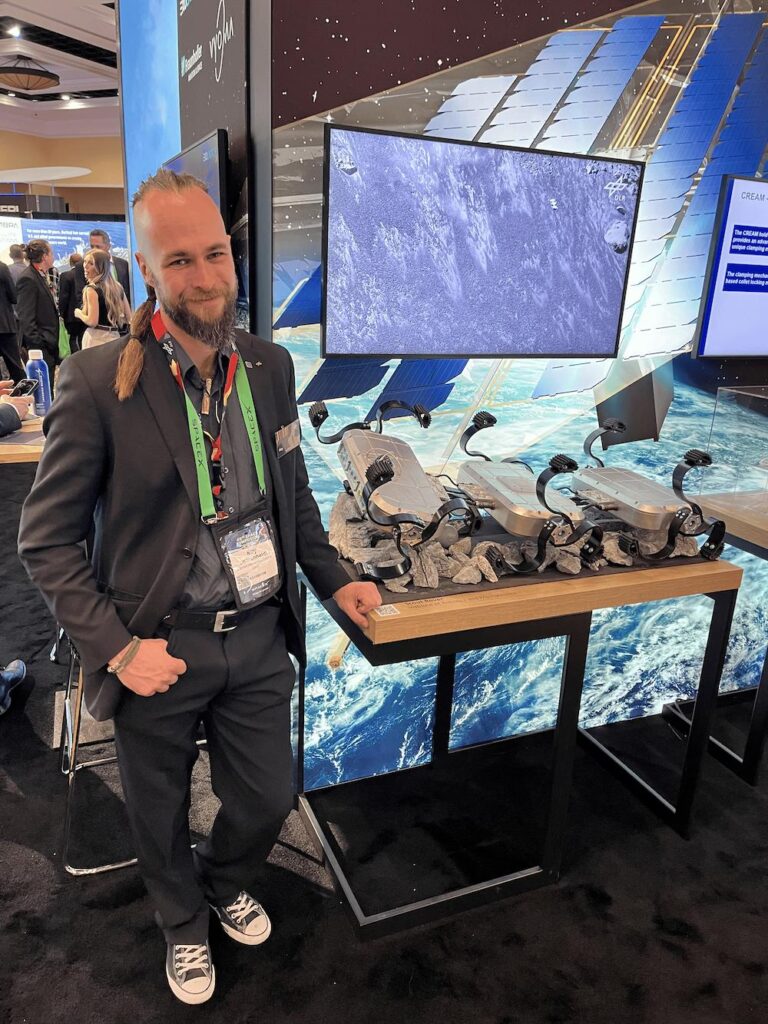
The German Aerospace Center (DLR), a hub of aerospace research and technology, consists of over 11,000 employees across 54 research institutes that tackles challenges in aeronautics, space exploration, energy, transport and security. Its mission is to explore Earth and space while developing cutting-edge technologies that benefit industries, governments and society at large.
What’s New: DLR showcased one of its many groundbreaking innovations, the Scout rover—a robust planetary exploration vehicle designed to navigate extreme terrains. According to Roy Lichtenheldt, the project’s manager, the Scout’s novel design, which features rimless wheels that enable a walking motion powered by a single motor per leg, positions it as an essential tool for future planetary research. Scout’s simplicity enhances reliability for missions on Mars and other celestial bodies. The rover’s primary goal is to explore subterranean environments where traces of life may be sheltered from radiation and temperature extremes.
What’s Next: DLR plans to enhance the Scout rover’s autonomy. Lichtenheldt explained that future iterations will allow the rover to independently decide its path, tackle objectives and communicate findings back to Earth. This autonomy is crucial for Mars missions where real-time human intervention is impossible. Learn more about DLR’s advancements in aerospace science and space exploration here.
Lithuania: Blackswan Space | Redefining Satellite Autonomy
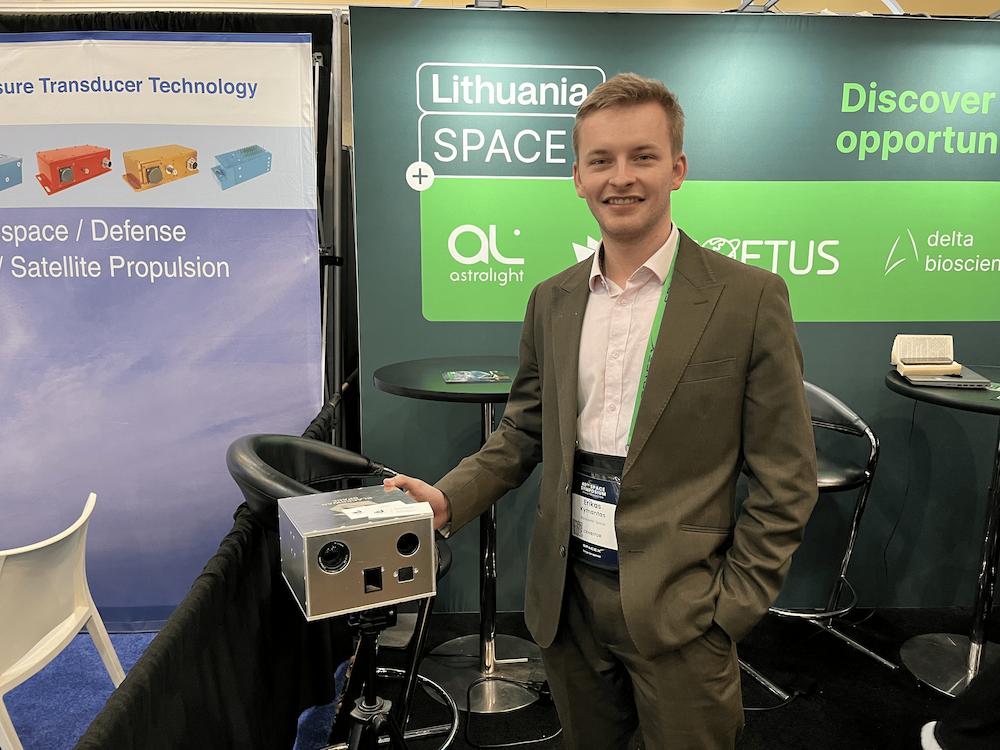
Blackswan Space, based in Vilnius, Lithuania, aims to redefine satellite autonomy. Specializing in cutting-edge technologies like autonomous navigation and mission simulation, the company enables satellites to perform complex in-orbit maneuvers independently. Its flagship tools—the Vision Based Navigation (VBN) system and Mission Design Simulator—are designed to empower satellite integrators and operators with next-generation capabilities for modern space missions, such as rendezvous operations, debris capture and robotic manipulation.
What’s New: Blackswan Space unveiled their latest breakthrough: a plug-and-play system combining machine learning algorithms with edge computing for real-time decision-making in orbit. This technology addresses diverse mission needs while reducing development redundancies across the industry. “We’re focused on creating kits that allow satellites to react to their environment instantaneously and handle multiple use cases like refueling and space domain awareness,” explained Erikas Kymantas, Systems Engineer at Blackswan Space.
Kymantas also highlighted the company’s Mission Design Simulator, which he said is being actively promoted to key industry players. This digital twin platform enables users to simulate missions in photorealistic environments while generating synthetic data for AI training in the VBN payload. The tool is particularly appealing to constellation managers and researchers seeking to optimize mission planning and enhance autonomous systems.
What’s Next: Blackswan plans an ambitious in-orbit demonstration of their VBN payload by 2027. With partnerships spanning Europe and Australia, Kymantas and the Blackswan team aim to push their technology readiness level even higher. For more information or a free demo of their software, visit Blackswan Space’s website.
Hungary: Bonn Hungary Electronics (BHE) | Smart Amplifier Technology

As a pioneer in RF and microwave technologies, Bonn Hungary Electronics (BHE) has been a cornerstone of innovation since its founding in 1991. Originally established as a German-Hungarian joint venture, BHE transitioned to a fully Hungarian-owned company, specializing in satellite communication systems. Their expertise spans both spaceborne and ground segments, with a strong focus on subsystems for satellite communication, including uplink and downlink solutions.
What’s New: BHE made its debut appearance at the Space Symposium, showcasing its groundbreaking “Smart Amplifier Technology.” Janos Solymosi, Director for Aerospace and Defense at BHE, explained that this innovation allows remote monitoring and control of communication systems from thousands of miles away. Designed to operate in extreme environments such as Antarctica or rural areas, the technology ensures seamless telemetry and payload communication for satellites. Microwave technology plays a critical role in this system. While optical communication is gaining traction, it requires direct visibility between the ground and space, which is not always feasible. According to Solymosi, RF and microwave communication, a tried-and-true method since the early days of satellite technology, remains the most reliable solution for consistent connectivity. He quipped, “Even the most expensive satellite is just a piece of hardware without reliable communication.”
What’s Next: BHE aims to expand its presence in the U.S. market, recognizing its immense potential. The company actively seeks partnerships to enhance joint missions and cooperation. To partner with BHE or learn more about how the company continues to advance global satellite communication systems visit their website here.
Luxembourg: HITEC | Cutting Edge Optical Antennas
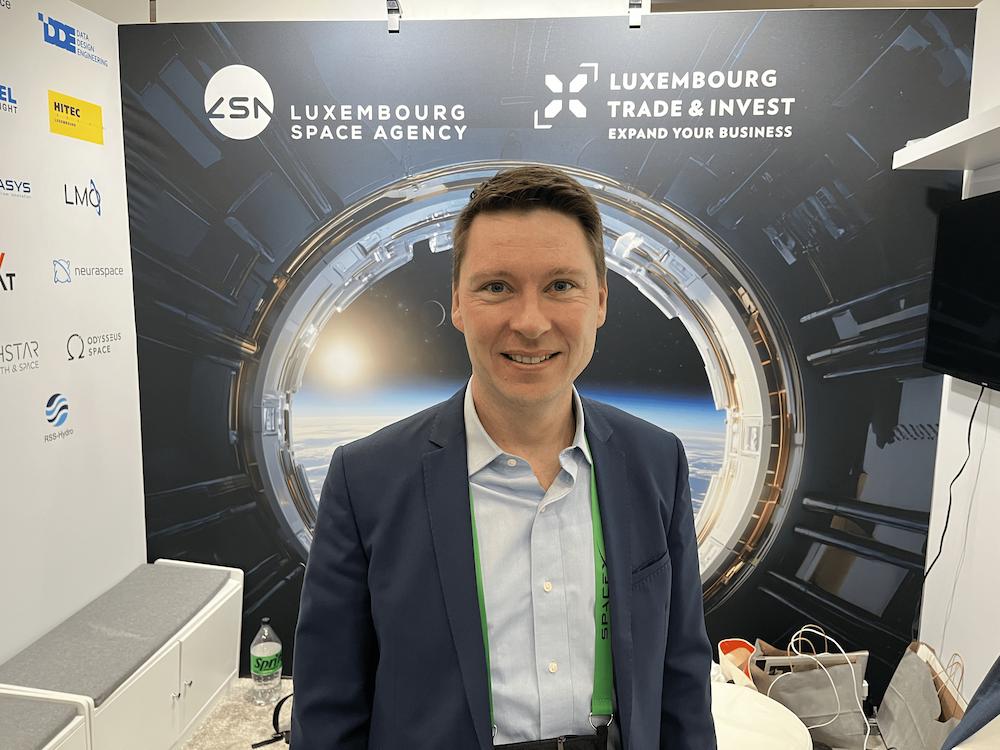
HITEC, a Luxembourg-based leader in ground segment technology, provides cutting-edge optical antennas for satellite communications. Specializing in solutions for geostationary (GEO), Middle Earth (MEO), and Low Earth Orbit (LEO) satellites, HITEC designs advanced ground station antennas that operate across radio frequencies and optics.
What’s New: Philippe Osch, a mechanical engineer who leads the company as CEO and has shaped its direction for over 15 years, discussed its groundbreaking optical ground station antennas developed together with its partner AMOS. These antennas enable direct satellite-to-ground laser communication, offering three transformative applications. First, they facilitate optical communications with higher data transfer rates compared to traditional radio frequencies—critical for modern data-intensive operations. Second, they support quantum key distribution (QKD), a next-generation encryption method crucial for safeguarding sensitive information against quantum computing threats. HITEC’s antennas uniquely enable the transmission of quantum keys via satellites, overcoming terrestrial optical link limitations. Lastly, the technology enables space situational awareness by allowing detection of orbital debris and monitoring irregular satellite activities, ensuring safer operations in increasingly crowded skies.
What’s Next: HITEC plans to expand its portfolio as adoption of these nascent technologies grows. The company is developing varied antenna sizes with enhanced precision to meet diverse customer needs. Currently in the prototyping phase, HITEC is poised to scale alongside its clients’ evolving applications in optical communications, QKD,and space monitoring. For more information on HITEC visit their website or connect via LinkedIn.
Slovenia: TIMTEC | Merging Space and Terrestrial Defense Technologies

TIMTEC, a Slovenia-based leader in advanced defense and space technologies known for its expertise in anti-drone systems, gimbal platforms and surveillance solutions, is now expanding into the space domain. Under the guidance of Martin Lamut, Space Sector Specialist, the company aims to integrate its robust terrestrial technologies with space applications, a significant evolution in its portfolio.
What’s New: Lamut focused on a few of TIMTEC’s groundbreaking new projects, developed in collaboration with the European Space Agency (ESA). One involves fusing data from unmanned aerial vehicles (UAVs) and satellites to enhance Earth observation capabilities. By leveraging artificial intelligence and machine learning algorithms, TIMTEC’s approach extracts high-fidelity insights from lower-resolution satellite data. This addresses critical challenges such as flood monitoring and optimizing hydroelectric power generation by accurately assessing water levels in narrow rivers, information often missed by conventional satellite systems.
What’s Next: TIMTEC has a few more projects in the queue, according to Lamut. TIMTEC’s ground-based systems, which are already adept at intercepting and managing communication signals, will be adapted for deployment in space. The goal is to create robust systems capable of facilitating secure and efficient communication between satellites and ground stations. This move not only enhances operational reliability but will also open doors to advanced functionalities such as real-time data transmission and improved network coordination.
Another exciting frontier for TIMTEC is its exploration of in-orbit servicing technologies. This involves developing methods for maintaining, repairing or even upgrading satellites directly in space—a capability that could significantly extend the lifespan of orbital assets. Learn more about how TIMTEC aims to play a pivotal role in shaping the future of satellite operations here.

